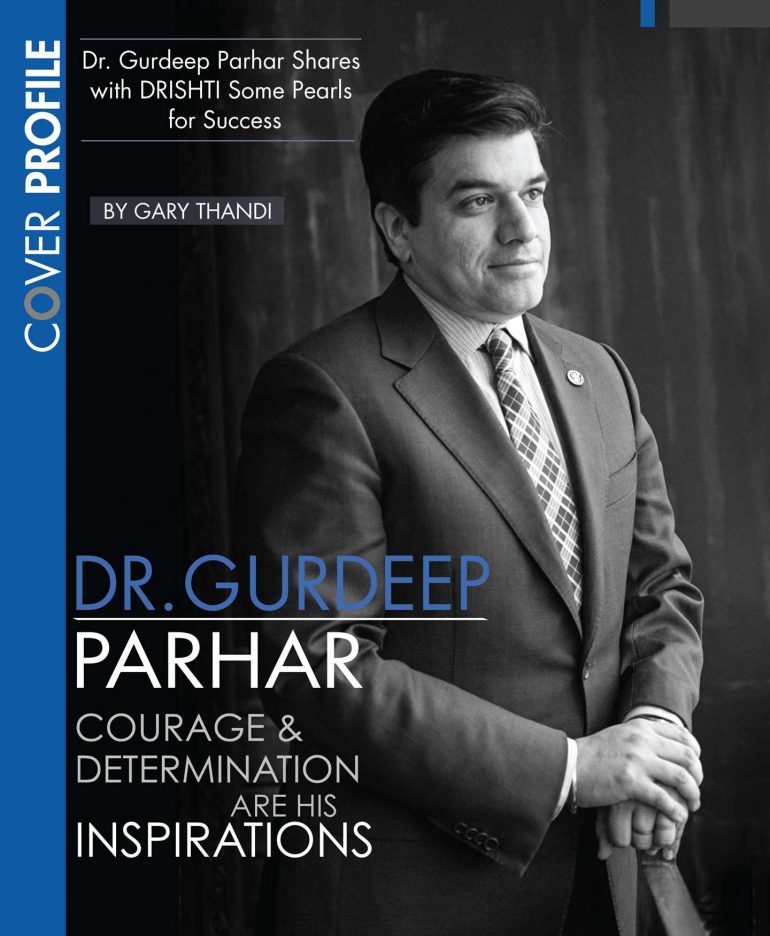Dr. Gurdeep Parhar Shares with DRISHTI Some Pearls for Success
TEDxStanleyPark is, according to the website, a not-for-profit “intellectual variety show” that is held annually in Vancouver. The ‘x’ in TEDx indicates the event is an independently organized TED Event; TEDx builds upon the same concept as a TED (Technology, Entertainment, Design) in that it features innovative minds whose ideas are helping to shape ideas and thoughts both within their fields and within societies at large.
At TEDxStanleyPark, presenters speak live about subject matter intended to shift attitudes and ultimately lead to positive social change. TEDxStanleyPark’s theme is “Ideas to Action.” Dr. Gurdeep Parhar is one of the select speakers for this event, to be held at Queen Elizabeth Theatre on Saturday May 28th 2016, in front of a live audience of over 2600 people as well as up to 5000 online guests. “It was a quite an honour to be chosen to speak at this event,” states Dr. Parhar.
Dr. Parhar was born in India, but moved at a very young age and grew up in Kitimat, in Northern BC. He received his MD from the University of Calgary in 1992 and completed his training at Royal Columbian Hospital in New Westminster, BC. “When I graduated I was the youngest doctor in Canada,” he said. “I graduated at age twenty-three.”
Dr. Parhar cites his late grandfather to be his inspiration. “As an adult, he was in an accident and had a leg amputated. He used to go all around Vancouver on transit and walking on one leg. He didn’t speak a word of English but still managed to get around and do what he needed to do.” Dr. Parhar recalls that his grandfather never complained about having lost his leg, nor did he use it as an excuse for not accomplishing things. “He had this challenge, yet it did not stop him. Thinking about his courage and determination drives me.” After years of general family practice, Dr. Parhar created the Pacific Coast Recovery Care center to address the needs of patients with severe injuries and disabilities. Throughout his decades of professional practice as a physician, Dr. Parhar acknowledges that what he values the most in his work is “developing relationships with patients, colleagues, and students.” He confesses that, “building relationships with people have always been important to me in the work that I do.”
Dr. Parhar also teaches at the University of British Columbia, on issues such as professionalism, equity, diversity, social determinants of health, and medical disability. He is the Executive Associate Dean, Clinical Partnerships and Professionalism. Previously he was the Associate Dean, Equity and Professionalism for the Faculty of Medicine, as well as the Co-Acting Head and Associate Head of the UBC Department of Family Practice.
Among his many honours, Dr. Parhar was awarded the BC College of Family Physicians’ Teacher of the Year Award in 2010, UBC’s Killam Teaching Prize which is UBC’s top teaching award, and the Alumnus of Distinction Award from the University of Calgary, Faculty of Medicine in 2011. In 2015, Dr. Parhar was given the May Cohen National Award for the Association Faculties of Medicine of Canada (AFMC) for Equity, Diversity, and Gender.
When asked about the future of medicine and health care, Dr. Parhar is optimistic about what is on the horizon. He notes that new graduates are more interested in working as part of inter-disciplinary teams instead of simply working in their own individual practice. Increasingly, he sees patients and all health care professionals recognizing the value of the entire health care team. Patients have the best outcomes when physicians work collaboratively with nurses, physiotherapists, occupational therapists, social workers, and counsellors. “It’s not about doing things on your own or being in solo practice,” he notes. “Back when I started, you could rent a space, set up a few examining tables, and start your own medical practice. Today, new graduates do not want to do that.”
Dr. Parhar also sees the future of healthcare increasingly involving technology. Telemedicine is one way technology is being utilized to provide improved access to healthcare for the entire population. For example, such technology is being used to reach rural and remote communities; the advantage of this Dr. Parhar asserts, is “that patients who are unable to see a health care professional close to where they live have access to a nurse, doctor, or specialist. In using video conference, patients can speak with a healthcare professional from a location that is convenient for them. It also saves patients money in travel costs.
At TEDxStanleyPark, Dr. Parhar will speak on the topic of “Fixing Racism.” He explains, “our brains work in a way that recognize patterns. So, if there is a person we see, for example, wearing a turban or a burka, we may assume certain things about that person. We need to recognize that we do it. That in itself does not make us racist. What we need to be aware and recognize is that this is our subconscious bias. If we do not recognize and understand this, we may subconsciously act in ways that are discriminatory.”
People often ask Dr. Parhar about his culture growing up. To this he replies that he grew up in a small northern British Columbian town, with “black bears, salmon fishing, street hockey and Brian Adams. Most often people are surprised by my response because they think I’m going to say ‘samosas, the Taj Mahal and the Kama Sutra! People often package me, and possibly people who look like me, like that.”
He also relates a story about a man he was treating who had tattoos all over his arms and body. The man was crying and when Dr. Parhar asked him what was wrong, the man said another doctor he had seen earlier asked him, “So, what drugs do you use?” This man had never taken illegal drugs, nor drank alcohol, but that other doctor assumed he had because of his appearance – that is of having visible tattoos. “It’s these stereotypes that we make of others based on our own biases that can influence how we perceive things and how we ultimately act.”
Given the pervasiveness of stereotyping and discrimination, how can we ‘fix’ racism and other forms of discrimination? Dr. Parhar suggests three key tasks. First, “recognize that you see colour. Seeing difference does not make you racist. People who say ‘I see everyone the same, I do not see colour’- I say, you should probably see an eye doctor. We all see colour.” Second, “when you see someone different than you, try to find something you have in common. Even just one thing. No matter where you are or what group you belong to, we all have things in common. For example, at the very least, we want basic things – we want to be safe, we want to be in good health, there are many things we have in common.” And third, “when you see someone who you perceive to belong to a particular group of people, let that interaction you have with that person inform you on how diverse people are, even if they seem to you to belong to “that group.” Try to learn something about that person you did not know about before.” He cites his mother as a prime example of someone who is far from a stereotype. “People see this older Indian woman, wearing an Indian suit, and no one would ever think she’s diehard Vancouver Canucks fan!”
Dr. Parhar is also the co-host and creator of the television program “Pearls for Success” on Shaw Multicultural Channel. The program educates the public – in particular, new Canadians – on topics related to education, health, law, and finance. “For people who have come over recently, the first one or two years is the hardest,” he explains, “and the show is focused on helping new immigrants and refugees navigate the Canadian system easier.” Some of the topics covered by the program include how to prepare for a check-up with a doctor, what a parent-teacher interview consists of, and how to make healthy lunches. The aim of program is to provide information that people can use on an everyday basis to enhance their overall functioning of our society. Dr. Parhar strongly believes that the countries in the world that are deemed to be the most successful are those that have achieved the best health and education for its citizens. Dr. Parhar’s co-host on “Pearls for Success” is his spouse, Dr. Anita Parhar, who teaches in the Faculty of Education and Faculty of Medicine at UBC.
Both Doctor Parhars are also proud parents of three children, in grades ten, eleven and twelve. He notes that when they get home and on weekends, the focus is on their children, their parents and their dog Tiger. Whenever he has free time, Dr. Parhar enjoys going to the theatre to watch plays and going on family vacations.
When asked if he has any advice to DRISTHI readers, Dr. Parhar says, “as a community, we need to remember our history. That is, our history not just in India and in other parts of the world, but our history here in Canada. Our community has been very successful in all areas of business and in all professions. We need to remember that we were given a helping hand, and we should also look to lend a helping hand to others that also need it. We got here because somebody did that for us, and we should never hesitate when someone needs our assistance. This does not necessarily mean that we give money – it can mean giving advice or sharing of wisdom.”
Believing strongly in universal health care, Dr. Parhar’s Pacific Coast Recovery Care centre’s services are meant to be accessible to all. There are no private fees or user fees for any of the medical services. Please contact the centre if you require any further information 604 526-0088 or email to info@pacificcoastrecoverycare.com For more on TEDxStanleyPark, including how to purchase tickets, visit the website at www.tedxstanleypark.com To learn more about the program “Pearls for Success” including airtimes, visit the website at www.pearlsforsuccess.com



